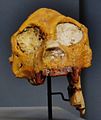Aegyptopithecus
| Aegyptopithecus | ||||||||||
|---|---|---|---|---|---|---|---|---|---|---|

Facial skull |
||||||||||
| Temporal occurrence | ||||||||||
| Lower Oligocene | ||||||||||
| 34 to 28 million years | ||||||||||
| Locations | ||||||||||
| Systematics | ||||||||||
|
||||||||||
| Scientific name | ||||||||||
| Aegyptopithecus | ||||||||||
| Simons, 1965 | ||||||||||
| species | ||||||||||
|
||||||||||
Aegyptopithecus is an extinct genus of primates that was found in Egypt around 30 million years ago. The first fossils of Aegyptopithecus were found in a quarry in Fayyum in the winter of 1963/64. Aegyptopithecus is one of the earliest known representative of the Old World monkeys , which today Cercopithecidae and apes belong, and was nearly as big today as living Gibbons .
Naming
Aegyptopithecus is an artificial word . The name of the genus refers to the place where it was found in Egypt and is also derived from the Greek word πηθηκος ( pronounced píthēkos in ancient Greek : "monkey"). The epithet of the type species, Aegyptopithecus zeuxis , is also borrowed from the Greek (zεῦξις) and, according to the first description, can be translated metaphorically as English yoke or join (to connect something), so it “refers to the morphology of the lower jaw and the teeth, the intermediate features between Propliopithecus and Dryopithecus . ” Aegyptopithecus zeuxis thus means“ monkey from Egypt who joins something ”.
Initial description
The holotype of the genus and type species Aegyptopithecus zeuxis is the fragment of a left lower jaw (archive number CGM 26901) with three preserved molars ( premolar P2 to molar M2) and a supplemented molar tooth M3 from the fossil YPM 21032. The paratype was identified in 1965 by Elwyn L. Simons identified the fragment of a second lower jaw with partially preserved tooth roots in the first description (archive number AMNH 13389). These fossils are stored in the Egyptian Geological Museum (formerly: Cairo Geology Museum , CGM), the Peabody Museum of Natural History in New Haven (Connecticut) , USA , (formerly: Yale Peabody Museum , YPM) and the American Museum of Natural History in New York City (AMNH).
features
The head of Aegyptopithecus zeuxis is characterized by the relatively long snout ( prognathy ) and the small brain (30 cm 3 ). As with all Old World monkeys, its tooth formula is 2-1-2-3 (that means two incisors , 1 canine , 2 front teeth and 3 molars per half of the jaw ). The size of the canine teeth shows a sexual dimorphism (the canine teeth of the males are larger than those of the females), which is also found in many primate species today. The structure of the teeth with wide, flat incisors and low molars probably corresponds pretty much to the original Old World monkey dentition.
The body skeleton shows essentially ape-like features, the forelimbs are short, the first toe can be opposed and a long tail is present. The weight of Aegyptopithecus is estimated to be around 6.7 kilograms. In 2004, an almost completely preserved, female skull was discovered with an internal volume of 14.6 cm³ and in which even the olfactory bulb of 0.102 cm³ could be reconstructed.
Presumably the animals lived in trees and moved slowly on the branches on four feet. From the structure of the teeth one deduces that the food mainly consisted of fruits and leaves.
The genus Aegyptopithecus was systematically classified with Propliopithecus and other genera in the group of Propliopithecidae , which is fairly close to the base of the Old World monkeys. However, they are not likely to be the immediate ancestors of today's monkey relatives or humans , but rather form a side branch.
literature
- John G. Fleagle and Elwyn L. Simons : The humerus of Aegyptopithecus zeuxis: A primitive anthropoid. In: American Journal of Physical Anthropology. Volume 59, No. 2, 1982, pp. 175-193, doi: 10.1002 / ajpa.1330590207 .
- Thomas M. Bown, Mary J. Kraus, Scott L. Wing, John G. Fleagle, Bruce H. Tiffney, Elwyn L. Simons, and Carl F. Vondra: The Fayum Primate Forest Revisited. In: Journal of Human Evolution. Volume 11, No. 7, 1982, pp. 603-632, doi: 10.1016 / S0047-2484 (82) 80008-0 .
- Richard F. Kay, John G. Fleagle, and Elwyn L. Simons: A revision of the Oligocene apes from the Fayum Province, Egypt. In: American Journal of Physical Anthropology. Volume 55, No. 3, 1981, pp. 293-322, doi: 10.1002 / ajpa.1330550305 .
- John G. Fleagle: Locomotor behavior of the earliest anthropoids: a review of the current evidence. In: Journal of Morphology and Anthropology. Volume 71, No. 2, 1980, pp. 149-156, abstract .
See also
Web links
Individual evidence
- ^ A b c Elwyn L. Simons : New Fossil Apes from Egypt and the Initial Differentiation of Hominoidea. In: Nature . Volume 205, 1965, pp. 135-139, doi: 10.1038 / 205135a0
- ↑ John G. Fleagle , Richard F. Kay and Elwyn L. Simons: Sexual dimorphism in early anthropoids. In: Nature. Volume 257, 1980, pp. 328-330, doi: 10.1038 / 287328a0
- ↑ Elwyn L. Simons, Erik R. Seiffert, Timothy M. Ryan and Yousry Attia: A remarkable female cranium of the early Oligocene anthropoid Aegyptopithecus zeuxis (Catarrhini, Propliopithecidae). In: PNAS . Volume 104, No. 21, 2007, pp. 8731-8736, doi: 10.1073 / pnas.0703129104



